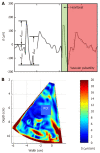Endogenous motion of liver correlates to the severity of portal hypertension
- PMID: 33132638
- PMCID: PMC7579755
- DOI: 10.3748/wjg.v26.i38.5836
Endogenous motion of liver correlates to the severity of portal hypertension
Abstract
Background: Degree of portal hypertension (PH) is the most important prognostic factor for the decompensation of liver cirrhosis and death, therefore adequate care for patients with liver cirrhosis requires timely detection and evaluation of the presence of clinically significant PH (CSPH) and severe PH (SPH). As the most accurate method for the assessment of PH is an invasive direct measurement of hepatic venous pressure gradient (HVPG), the search for non-invasive methods to diagnose these conditions is actively ongoing.
Aim: To evaluate the feasibility of parameters of endogenously induced displacements and strain of liver to assess degree of PH.
Methods: Of 36 patients with liver cirrhosis and measured HVPG were included in the case-control study. Endogenous motion of the liver was characterized by derived parameters of region average tissue displacement signal (d antero, dr etro, d RMS) and results of endogenous tissue strain imaging using specific radiofrequency signal processing algorithm. Average endogenous strain µ and standard deviation σ of strain were assessed in the regions of interest (ROI) (1 cm × 1 cm and 2 cm × 2 cm in size) and different frequency subbands of endogenous motion (0-10 Hz and 10-20 Hz).
Results: Four parameters showed statistically significant (P < 0.05) correlation with HVPG measurement. The strongest correlation was obtained for the standard deviation of strain (estimated at 0-10 Hz and 2 cm × 2 cm ROI size). Three parameters showed statistically significant differences between patient groups with CSPH, but only d retro showed significant results in SPH analysis. According to ROC analysis area under the curve (AUC) of the σ ROI[0…10Hz, 2 cm × 2 cm] parameter reached 0.71 (P = 0.036) for the diagnosis of CSPH; with a cut-off value of 1.28 μm/cm providing 73% sensitivity and 70% specificity. AUC for the diagnosis of CSPH for µ ROI[0…10Hz, 1 cm × 1 cm] was 0.78 (P = 0.0024); with a cut-off value of 3.92 μm/cm providing 73% sensitivity and 80% specificity. D retro parameter had an AUC of 0.86 (P = 0.0001) for the diagnosis of CSPH and 0.84 (P = 0.0001) for the diagnosis of SPH. A cut-off value of -132.34 μm yielded 100% sensitivity for both conditions, whereas specificity was 80% and 72% for CSPH and SPH respectively.
Conclusion: The parameters of endogenously induced displacements and strain of the liver correlated with HVPG and might be used for non-invasive diagnosis of PH.
Keywords: Endogenous motion; Hepatic venous pressure gradient; Portal hypertension; Radiofrequency parameters; Strain elastography.
©The Author(s) 2020. Published by Baishideng Publishing Group Inc. All rights reserved.
Conflict of interest statement
Conflict-of-interest statement: None declared.
Figures







Similar articles
-
Evaluation of portal hypertension by real-time shear wave elastography in cirrhotic patients.Liver Int. 2015 Nov;35(11):2416-24. doi: 10.1111/liv.12846. Epub 2015 May 5. Liver Int. 2015. PMID: 25875718
-
Plasma Nogo-A and placental growth factor levels are associated with portal hypertension in patients with liver cirrhosis.World J Gastroenterol. 2019 Jun 21;25(23):2935-2946. doi: 10.3748/wjg.v25.i23.2935. World J Gastroenterol. 2019. PMID: 31249451 Free PMC article.
-
Noninvasive Evaluation of Clinically Significant Portal Hypertension in Patients with Liver Cirrhosis: The Role of Contrast-Enhanced Ultrasound Perfusion Imaging and Elastography.Ultraschall Med. 2023 Aug;44(4):428-435. doi: 10.1055/a-1933-2847. Epub 2022 Dec 16. Ultraschall Med. 2023. PMID: 36526267 English.
-
von Willebrand factor as a biomarker of clinically significant portal hypertension and severe portal hypertension: a systematic review and meta-analysis.BMJ Open. 2019 Aug 30;9(8):e025656. doi: 10.1136/bmjopen-2018-025656. BMJ Open. 2019. PMID: 31473610 Free PMC article.
-
Performance of spleen stiffness measurement in prediction of clinical significant portal hypertension: A meta-analysis.Clin Res Hepatol Gastroenterol. 2018 Jun;42(3):216-226. doi: 10.1016/j.clinre.2017.11.002. Epub 2017 Dec 6. Clin Res Hepatol Gastroenterol. 2018. PMID: 29223365
Cited by
-
Portal vein computed tomography imaging characteristics and their relationship with bleeding risk in patients with liver cirrhosis undergoing interventional therapy.World J Clin Cases. 2023 Jun 26;11(18):4277-4286. doi: 10.12998/wjcc.v11.i18.4277. World J Clin Cases. 2023. PMID: 37449217 Free PMC article.
References
-
- Marcellin P, Kutala BK. Liver diseases: A major, neglected global public health problem requiring urgent actions and large-scale screening. Liver Int. 2018;38 Suppl 1:2–6. - PubMed
-
- Silkauskaitė V, Kupčinskas J, Pranculis A, Jonaitis L, Petrenkienė V, Kupčinskas L. Acute and 14-day hepatic venous pressure gradient response to carvedilol and nebivolol in patients with liver cirrhosis. Medicina (Kaunas) 2013;49:467–473. - PubMed
MeSH terms
LinkOut - more resources
Full Text Sources
Research Materials

